When this small-bodied, small-brained hominin was discovered, it proved that our early human relatives habitually walked on two legs.
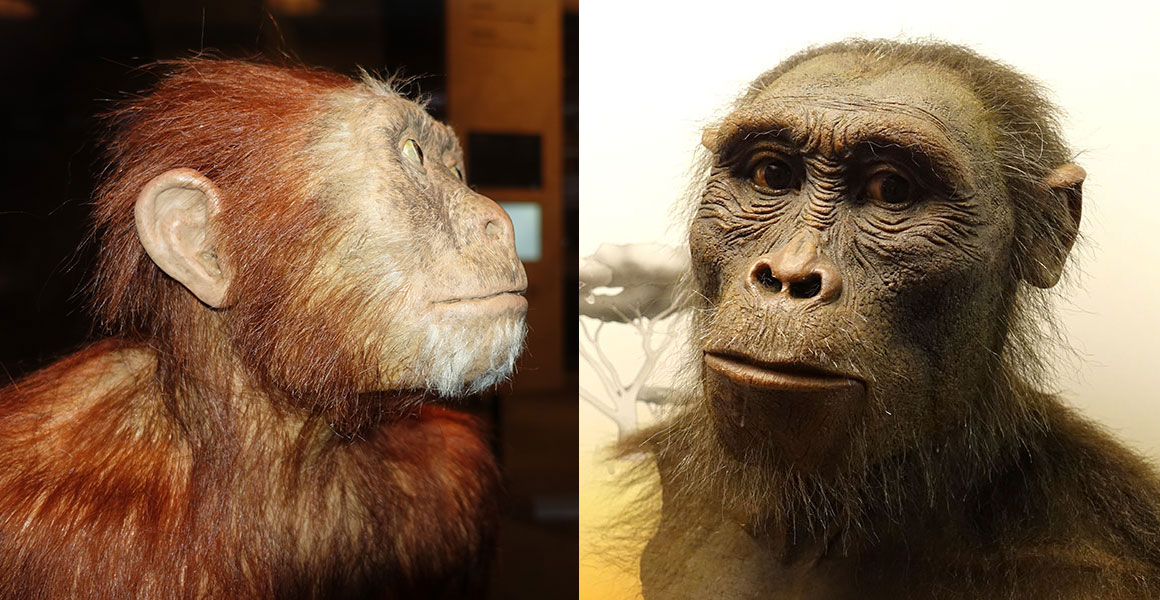
Facial reconstructions of what the early hominin (human relative) Australopithecus afarensis may have looked like © left image by Ellywa [CC BY-SA 4.0], right image by Daderot [CC0 1.0], both from Wikimedia Commons
Its story began to take shape in late November 1974 in Ethiopia, with the discovery of the skeleton of a small female, nicknamed Lucy.
More than 40 years later, Australopithecus afarensis is one of the best-represented species in the hominin fossil record.
Australopithecus afarensis facts
- Lived: 3.7 million to three million years ago
- Where: East Africa
- Appearance: a projecting face, an upright stance and a mixture of ape-like and human-like body features
- Brain size: about 385-550cm3
- Height: about 1-1.7m (females were much shorter than males)
- Weight: about 25-64kg (females were significantly smaller than males)
- Diet: plants including grasses, fruits and leaves
- Species named in: 1978, four years after the discovery of Lucy
- Name meaning: 'southern ape from Afar' (Afar is a region of Ethiopia)
How Australopithecus afarensis changed our understanding of human evolution
Au. afarensis belongs to the genus Australopithecus, a group of small-bodied and small-brained early hominin species (human relatives) that were capable of upright walking but not well adapted for travelling long distances on the ground.
Species in the australopith group - which also includes Au. africanus, Au. sediba, Au. anamensis and Kenyanthropus platyops - probably gave rise to two more recent hominin groups, Homo and Paranthropus, before 2.5 million years ago.
Au. afarensis wasn't the first member of the group discovered - that was the Au. africanus from South Africa - but its discovery confirmed our ancient relatives habitually walked upright, and that this feature of the human lineage occurred long before the evolution of bigger brains.
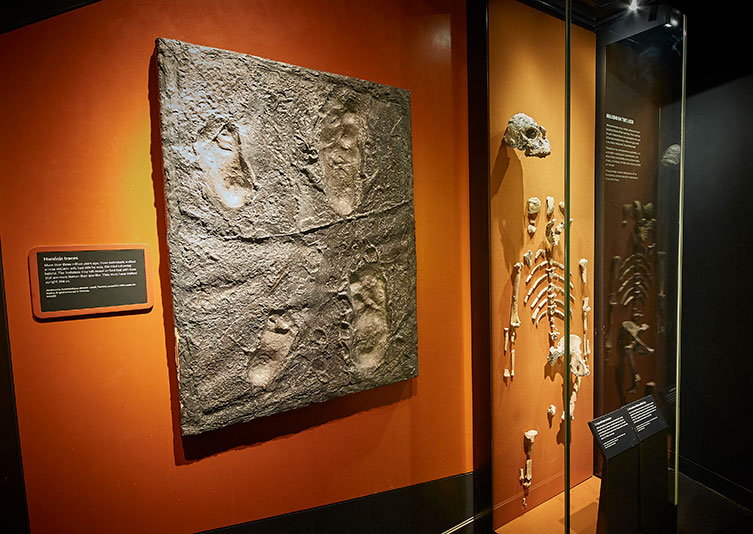
Australopithecus afarensis discoveries in the 1970s, including Lucy and the Laetoli fooprints, confirmed our ancient relatives were bipedal - walking upright on two legs - before big brains evolved. Replicas are on display in the Museum's Human Evolution gallery, alongside the skull of Kenyanthropus platyops, another hominin species that lived in East Africa during the same period.
The ability to walk upright may have offered survival benefits, such as the ability to spot dangerous predators earlier. Perhaps crucially, it left the hands free to do other tasks, such as carry food and use tools.
When did Australopithecus afarensis live?
According to the fossils recovered to date, Au. afarensis lived between 3.7 and three million years ago. This means the species survived for at least 700,000 years, more than twice as long as our own species, Homo sapiens, has been around.
Where did Australopithecus afarensis live?
Au. afarensis fossils have been unearthed in Ethiopia, Kenya and Tanzania.
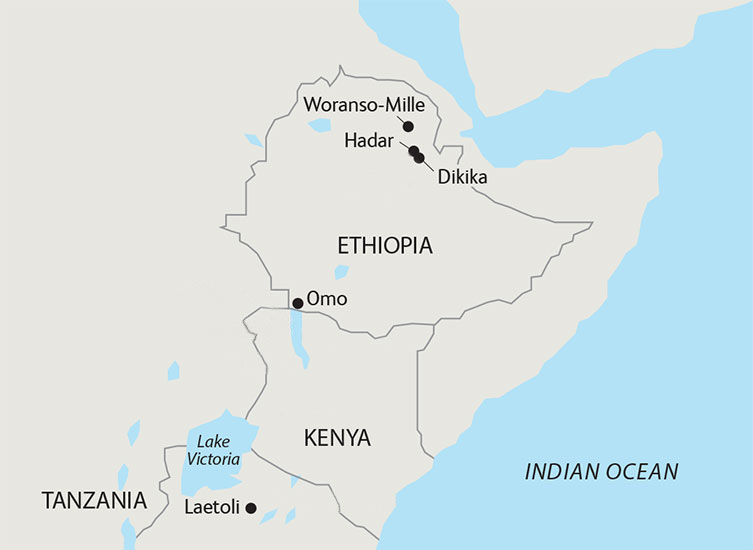
Map showing sites in Tanzania and Ethiopia where Australopithecus afarensis fossils have been found at Laetoli, Omo, Hadar, Woranso-Mille and Dikika. They have also been found at Lake Turkana in Kenya.
Who is Lucy the Australopithecus?
Lucy was one of the first hominin fossils to become a household name. Her skeleton is around 40% complete - at the time of her discovery, she was by far the most complete early hominin known.
On 24 November 1974, palaeoanthropologist Donald Johanson was exploring the ravines and valleys of the Hadar river in the Afar region of northeastern Ethiopia when he spotted an arm bone fragment poking out of a slope.
Johanson later recounted that his pulse quickened as he realised it belonged not to a monkey but a hominin. As the team found more and more fragments, they began to appreciate that they were uncovering an extraordinary skeleton. The full excavation took three weeks.
Lucy's skeleton consists of 47 out of 207 bones, including parts of the arms, legs, spine, ribs and pelvis, as well as the lower jaw and several other skull fragments. However, most of the hand and foot bones are missing.
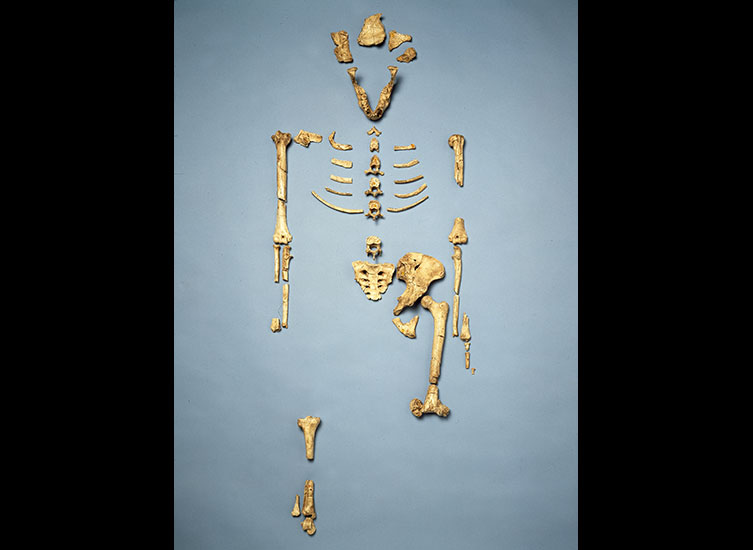
A cast of Lucy, the partial skeleton of an Australopithecus afarensis female found at Hadar, in the Afar region of Ethiopia. The fossil is slightly less than 3.18 million years old.
None of the bones were duplicates, supporting the conclusion that they came from a single individual.
The shape of the pelvic bones revealed the individual was female.
Lucy measured just 1.05 metres tall and would have weighed around 28kg. Yet an erupted wisdom tooth and the fact that certain bones were fused suggested Lucy was a young adult.
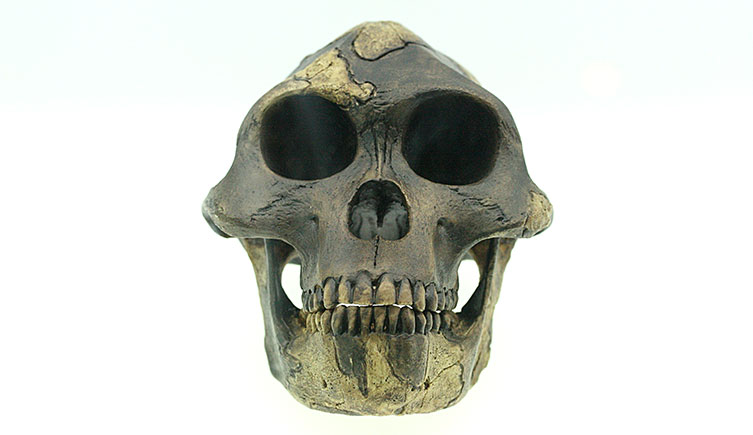
Reconstruction of Lucy's skull at the Naturhistorisches Museum Basel, based on a lower jaw bone and several other skull fragments. An erupted wisdom tooth provided evidence that Lucy was a young adult when she died. © Pbuergler [CC BY-SA 3.0], from Wikimedia Commons
The affectionate nickname comes from the Beatles' song Lucy in the Sky with Diamonds, which was often playing from the team's tape recorder back at camp.
The formal attribution AL 288-1 is rarely used beyond academic journals. The skeleton is slightly less than 3.18 million years old.
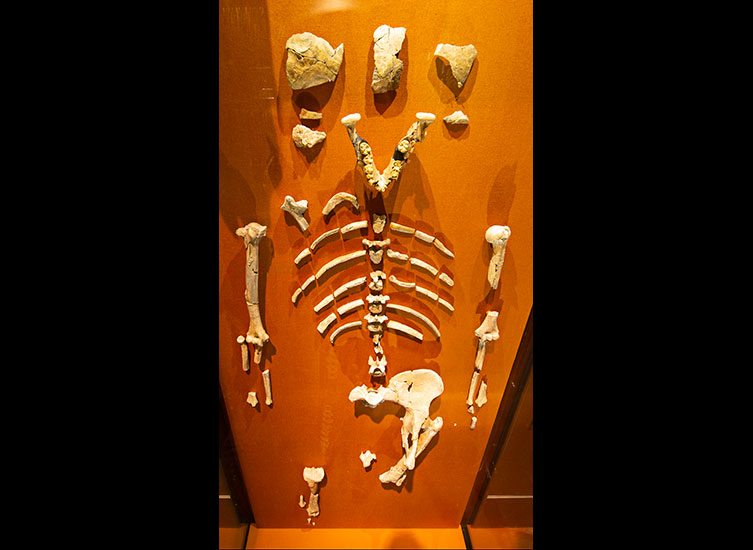
A cast of Lucy on display in the Museum's Human Evolution gallery. Her small skull, long arms and conical rib cage are like an ape's, but she has a more human-like spine, pelvis and knee due to walking upright.
Johanson thought Lucy was either a small member of the genus Homo or a small australopithecine. Only after analysing other fossils subsequently uncovered nearby and at Laetoli in Kenya did scientists establish a new species, Australopithecus afarensis, four years after Lucy's discovery.
At the time, Au. afarensis was the oldest hominin species known, although far older species have since been found.
How did Lucy die?
Researchers studied injuries to Lucy's bones to see whether they offered insights into how she died, publishing their findings in 2016.
CT scans revealed fractures in her shoulder joint and arms similar to those observed in people who fall from a great height, as if she reached out to break her fall. They also indicated that many of the breaks occurred perimortem, around the time of death, rather than over time as the bones became fossilised.
The researchers believe the injuries observed were severe enough that internal organs could also have been damaged. Based on their evidence, the team suggest that Lucy died falling out of a tree.
However, this conclusion is controversial and many scientists, including Johanson, say there are other plausible explanations for the breakages, such as being trampled by stampeding animals after death.
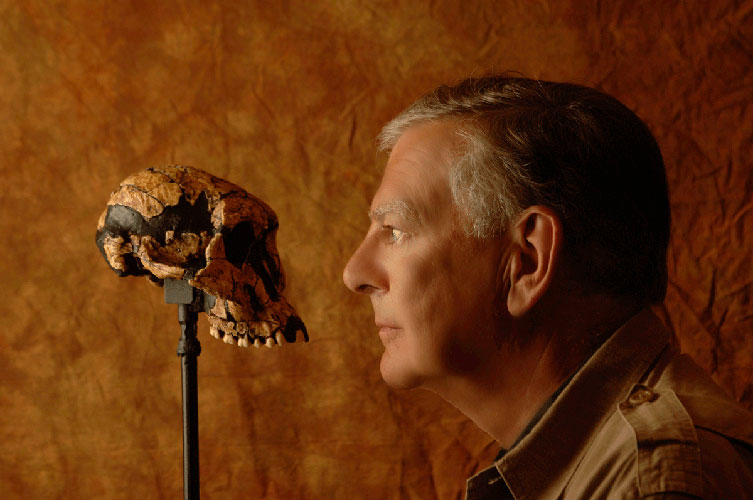
Prof Donald Johanson, discoverer of Lucy and other Australopithecus afarensis fossils, face-to-face with the skull of another early hominin. Image courtesy of Julesasu [CC0], from Wikimedia Commons
Australopithecus afarensis characteristics
Au. afarensis possessed both ape-like and human-like characteristics.
The top of its skull (the cranial vault) was slightly domed and its brain was comparable in size to a chimpanzee's. Its face projected outwards, less so in females than in males.
Some Au. afarensis skull specimens show evidence this species possessed powerful chewing muscles.
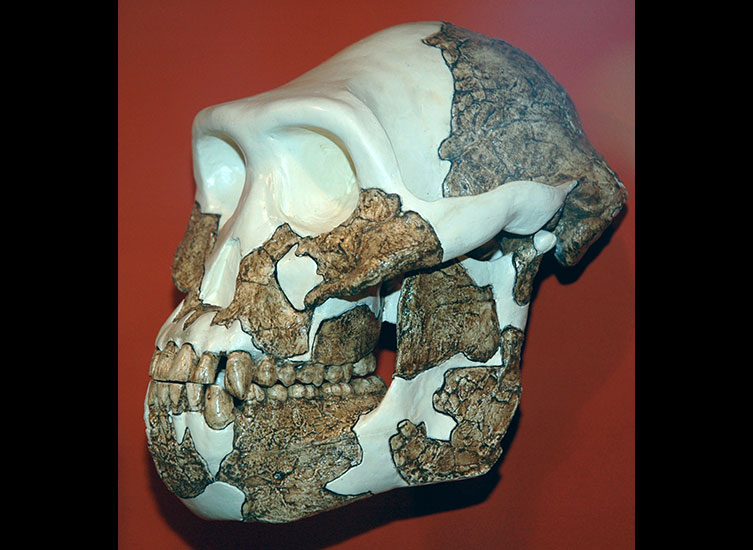
The small skull, long arms and conical ribcage were like an ape's, while the spine, pelvis and knees were more human-like.
The smallest Au. afarensis adults weighed an estimated 25 kilograms, while the largest weighed about 64 kilograms.
This is a broad range, pointing to high sexual dimorphism - the difference in size and shape between males and females. Modern humans have a low level of sexual dimorphism and the two sexes look very similar, whereas gorillas are very sexually dimorphic. The difference between Au. afarensis males and females is similar to the latter.
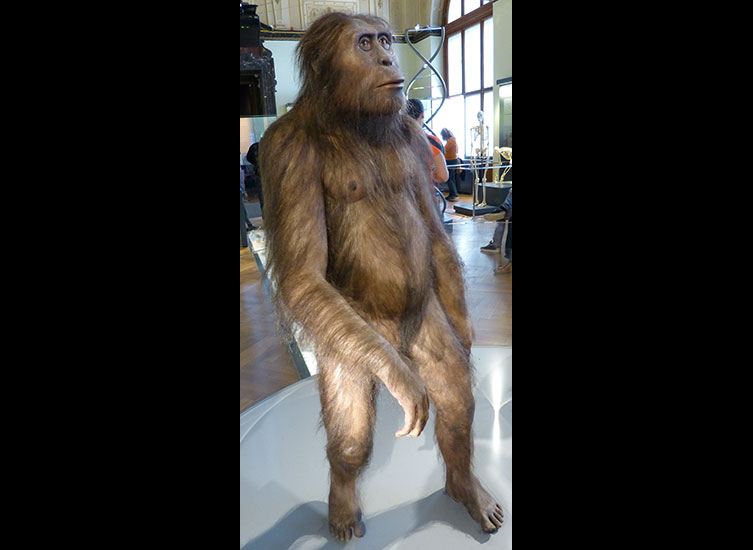
Model of a male Australopithecus afarensis in the Vienna Natural History Museum showing the ape-like long arms and the more human-like feet and upright stance © Wolfgang Sauber [CC BY-SA 4.0], from Wikimedia Commons
Au. afarensis is generally depicted with body hair as it was likely lost later in human evolution.
Australopithecus teeth
Au. afarensis has a number of distinctive dental features.
In some members of the species the tooth rows diverge slightly towards the back, forming a dental arcade (the part of the mouth where teeth sit) that is neither parallel-sided as in modern apes nor more rounded as in humans.
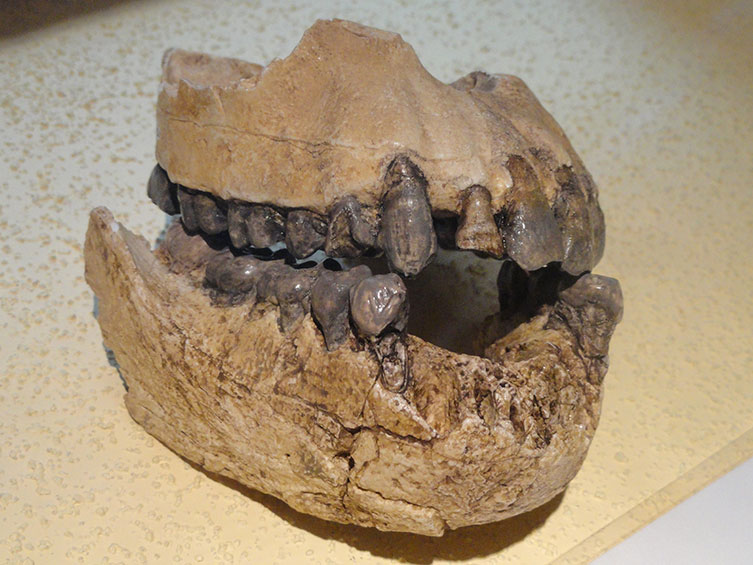
Australopithecus afarensis jaw replica. Exhibit in the Arppeanum, Helsinki. Image courtesy of Daderot [CC0 1.0], from Wikipedia Commons
The canine teeth of Au. afarensis are much smaller than those of chimpanzees, and they are narrower and differently shaped to those of the earlier Au. anamensis. The canine premolar honing complex has been completely lost - this is a feature present in chimpanzees and other apes outside of the hominin lineage, where the large and projecting upper canine teeth are sharpened against the lower third premolars. All known modern and fossil apes have this honing complex. Its absence, along with the presence of bipedalism, is thought to be characteristic of species on the hominin lineage.
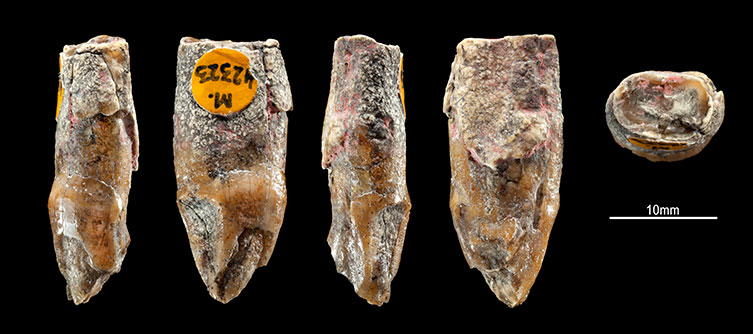
The 3.5-million-year-old Laetoli canine belonging to Australopithecus afarensis is the oldest hominin fossil in the Museum's collection. You can see it in the Human Evolution gallery.
How did Australopithecus afarensis move around?
Au. afarensis was competent at walking upright on two legs, and skeletal features indicate it did so regularly. However, it may not have walked in exactly the same way as we do or been able to walk long distances efficiently.
Anatomical features associated with upright walking are present in the spine, pelvis, legs and feet. These include a broad pelvis and a femur that is angled inwards towards the knee so that the centre of gravity lies directly above the foot.
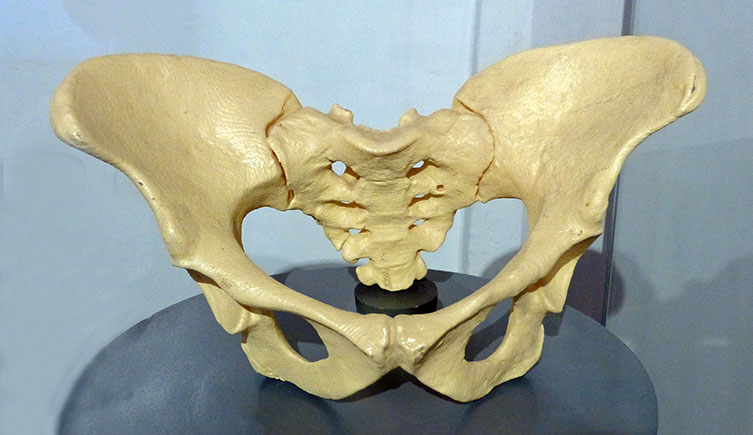
Reconstruction of Lucy's pelvis in the National Museum of Ethiopia. The broad pelvis of Australopithecus afarensis is an adaptation to upright walking. © Ji-Elle [CC BY-SA 3.0], from Wikimedia Commons
Lucy and her species also retained some adaptations for climbing and hanging from trees. These features are seen in the shoulders, arms, wrists and hands.
It is likely that the species, particularly the smaller females, spent a significant amount of time moving around in trees. The larger males were probably less arboreal.
Au. afarensis may have foraged in the tree canopy as well as on the ground, and probably retreated to the trees at night to avoid predators and for a good night's sleep. Chimpanzees and other apes are known to build nesting platforms in tree canopies.
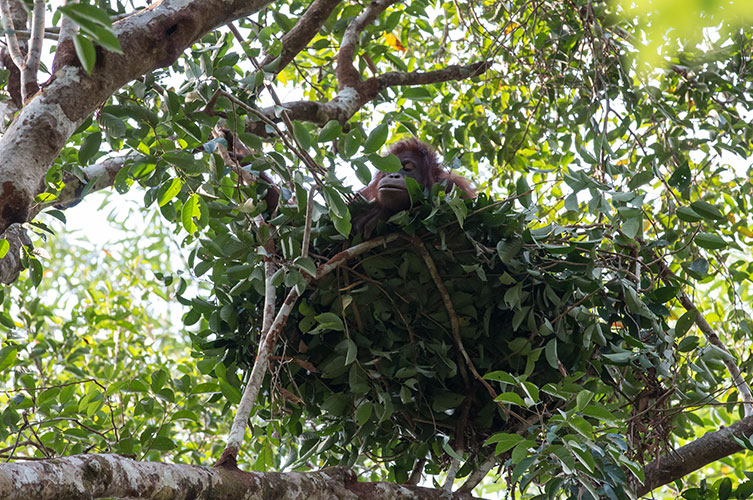
Australopithecus afarensis probably slept in trees for safety, like chimpanzees and orang-utans that build nesting platforms © Torsten Pursche/Shutterstock.com
Laetoli footprints - a snapshot in time
The site of Laetoli in Tanzania preserves the oldest known hominin footprints. Nearly 3.7 million years ago, a volcanic eruption covered the landscape with a layer of fine ash. Rain created a surface like wet cement and, before it hardened, a variety of animals wandered across it. Further eruptions covered the footprints they left behind, preserving them for posterity.
More than 20 species left tracks, including rhinoceroses, giraffes and baboons.
In 1978, two years after the first animal prints were uncovered, palaeoanthropologist Mary Leakey excavated a 27-metre-long trail made by hominins, consisting of about 70 footprints. They were attributed to Au. afarensis, to this day the most likely candidate as only this species has been found at Laetoli.
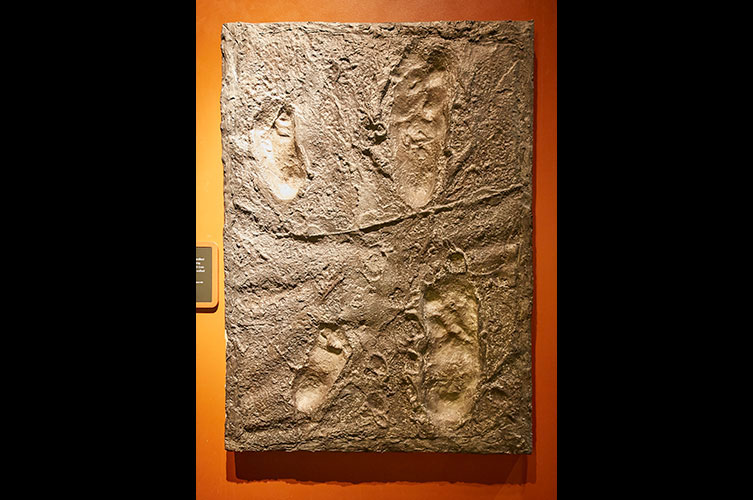
Replica in the Museum's Human Evolution gallery of some of the footprints preserved at Laetoli, Tanzania, thought to be made by Australopithecus afarensis. The tracks show two individuals walked side by side and a third followed behind. Their toes and way of walking were more human than ape-like.
According to the close spacing of the footprints, the hominins who made them had short legs. The prints resemble those of modern humans, with an arch and a big toe aligned with the other toes. Their steps were also similar to those of modern humans, with the heel touching the ground first and weight transferring to the ball of the foot before the toes push the foot off the ground. Biomechanical analysis suggests the bipedal gait was not entirely modern though, and that the leg may have been slightly more bent at the knee as the foot hit the floor.
The impressions left in the ash reveal that a small group - with different sized feet - were walking from south to north. At least one smaller individual was walking behind and stepping into the footprints made by a larger individual.
Nearly forty years later, another set of footprints was found 150 metres from the original trail. These were made by two individuals, one of whom was much taller and heavier, walking in the same direction as the original group. Perhaps a single social group made the two trails, possibly a large male walking with females and children.
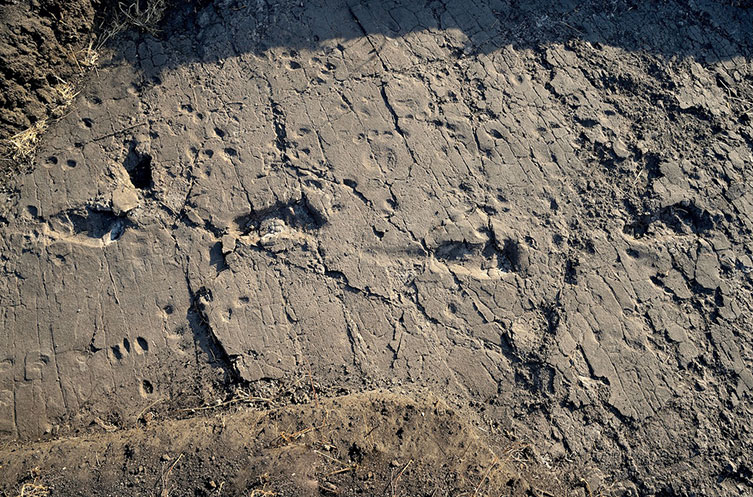
A second set of footprints, also nearly 3.7 million years old, were uncovered at Laetoli in 2015. It's quite rare to find footprints of hominins, the group to which humans and our ancestors and close relatives belong. The footprints at Laetoli are the only ones attributed to a species not in the genus Homo. © Masao et al (2016) eLife DOI: 10.7554/eLife.19568, licensed under CC BY 4.0
What did Australopithecus afarensis eat?
Various lines of evidence suggest that Au. afarensis ate a slightly different diet to that of earlier hominins.
Carbon isotope values in tooth enamel reveal that Au. afarensis is currently the earliest hominin species showing evidence for a more diverse diet that included savannah-based foods such as sedges or grasses, as well as a more traditional diet based on fruits and leaves from trees and shrubs.
Some of the anatomical changes compared to the earlier species Au. anamensis suggest there was a change in diet towards foods that were harder or tougher over time, as Au. afarensis has adaptations for heavy chewing.
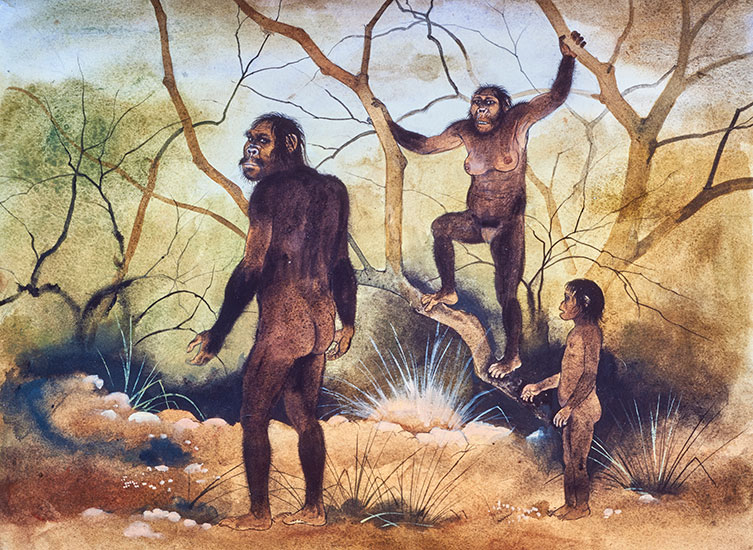
Illustration by Maurice Wilson of the extinct hominin Australopithecus afarensis. This species walked upright but retained the ability to climb trees. It may have searched for food there, as well as on the ground.
Did Australopithecus afarensis use tools?
Since our closest living relatives, chimpanzees, as well as other apes and monkeys, have been observed making and using simple tools, it is likely that all hominins made use of tools to some extent.
No tools have yet been directly associated with Au. afarensis. However, Australopithecus species had hands that were well suited for the controlled manipulation of objects, and they probably did use tools.
The oldest known stone tools are around 3.3 million years old and were unearthed in Kenya. These Lomekwian tools were made from volcanic rock and crafted into cores, flakes and potential anvils. Although Au. afarensis is known from Kenya around this time, the most likely candidate for the toolmaker is another species called Kenyanthropus platyops, as specimens of this hominin have been found close to where the tools were excavated.
A small number of animal bones found at Dikika in Ethiopia, have been reported as showing cut marks made by stone tools. They have been dated to about 3.4 million years ago and the team involved attribute the butchery to Au. afarensis, as this is the only species known to live in the area at this time. However, the conclusions are contentious. If they withstand scrutiny, this would be the earliest evidence of meat-eating behaviour by a hominin.
Important Australopithecus afarensis fossils
A number of other significant Au. afarensis finds have been made in addition to Lucy and the Laetoli footprints.
- Knee, AL 129 1a + 1b
Uncovered in 1973, this was the first hominin fossil found at Hadar in Ethiopia. The anatomy of the knee joint indicated it belonged to a species that walked on two legs and, at the time, it was the oldest evidence of a biped. It encouraged Johanson's team to return to the area, where they found Lucy the following year.
- Lower jaw, LH 4
This jaw bone containing nine teeth was discovered in 1974 by Mary Leakey at Laetoli in Tanzania. It was designated the type specimen for Au. afarensis, making it the specimen that officially represents the species and to which other potential Au. afarensis fossils need to be compared.
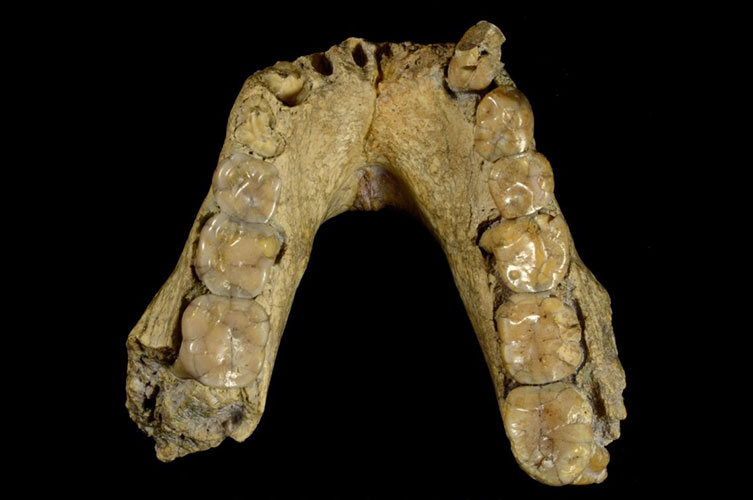
The Australopithecus afarensis type specimen - the LH 4 jaw bone from Laetoli, Tanzania, that officially represents the species. Credit: photo by F Spoor, courtesy of the National Museum of Tanzania.
- The first family, AL 333
In 1975, more than 200 hominin fossils were unearthed from Hadar. They represent at least 13 individuals, including four children. Scientists think they were probably related. The specimens support the notion that Au. afarensis was significantly sexually dimorphic. Other than their size, the group showed nearly identical anatomical features, showing they were all the same species. Whatever disaster befell the group, it happened around 3.2 million years ago.
- Kadanuumuu, KSD-VP-1/1
Unearthed in Ethiopia between 2005 and 2009, this partial skeleton is similarly complete to Lucy but much older, dating to about 3.6 million years ago. It belonged to a male that was about 1.6 metres tall, about 30% bigger than Lucy. The nickname Kadanuumuu means 'Big Man' in the Afar language.
Due to the lack of skull or dental parts to compare with the Au. afarensis type specimen, some scientists question whether Kadanuumuu can be assigned to this species.
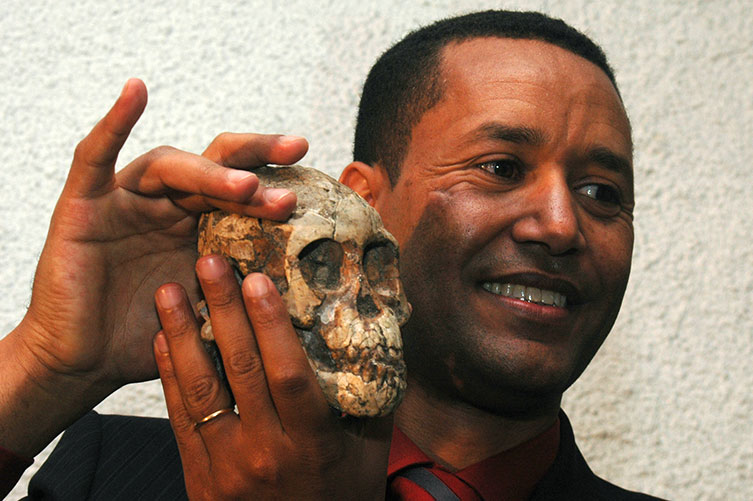
Ethiopian palaeontologist Zeresenay Alemseged holding the skull of Selam © Andrew Heavens [CC BY-NC-ND 2.0], from Flickr
- Selam, an Australopithecus afarensis child, DIK-1-1
An almost complete skeleton of a tiny Au. afarensis child was found at Dikika in Ethiopia in 2006. More than five years of painstaking excavation revealed previously unknown aspects of the species. CT scans of the skull showed the child's dental development was similar to a three-year-old chimpanzee. From the lack of marks from predators or scavengers, it appears the child died naturally or in an accident and was quickly buried, perhaps by a flash flood.
This article includes information from Our Human Story by Dr Louise Humphrey and Prof Chris Stringer.
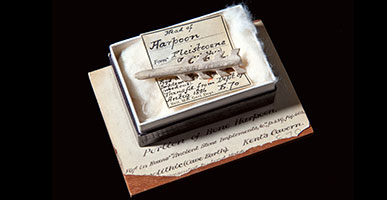
Explore human evolution
Museum science is helping to answer where, when and how humans evolved.
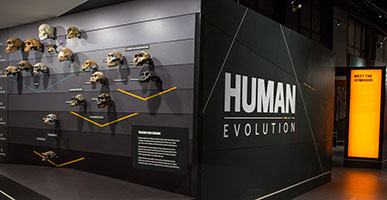
Meet your ancient relatives
Embark on a seven-million-year journey of evolution and see fossil and artefact discoveries in the Human Evolution gallery.
What links people and pangolins?
Explore our origins with Professor Anjali Goswami as we trace 200 million years of evolution in our online and on-demand course.
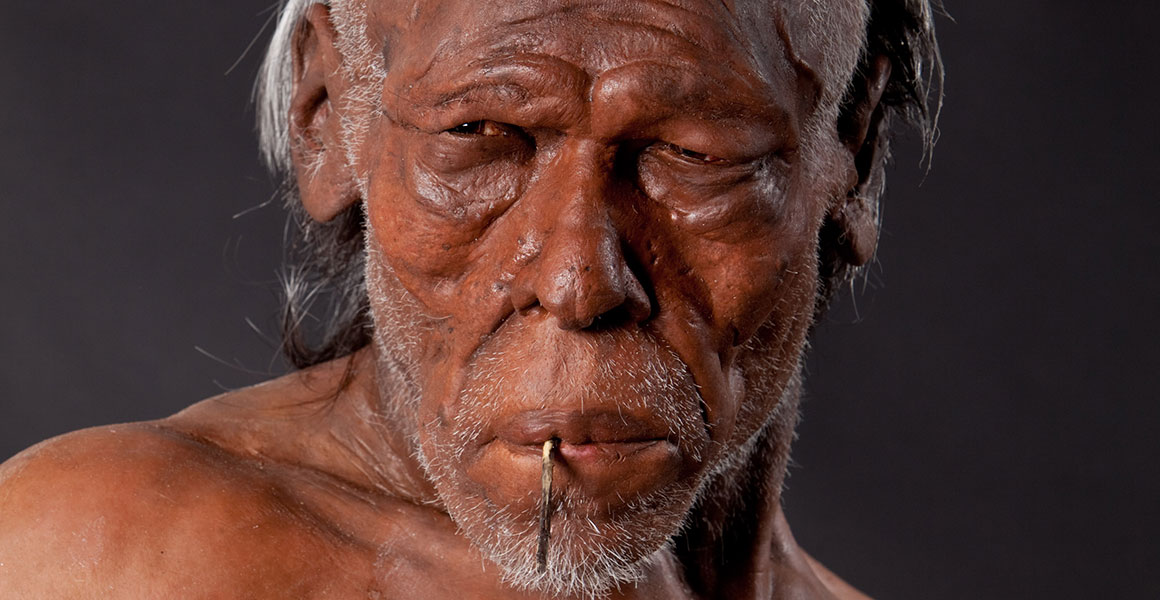
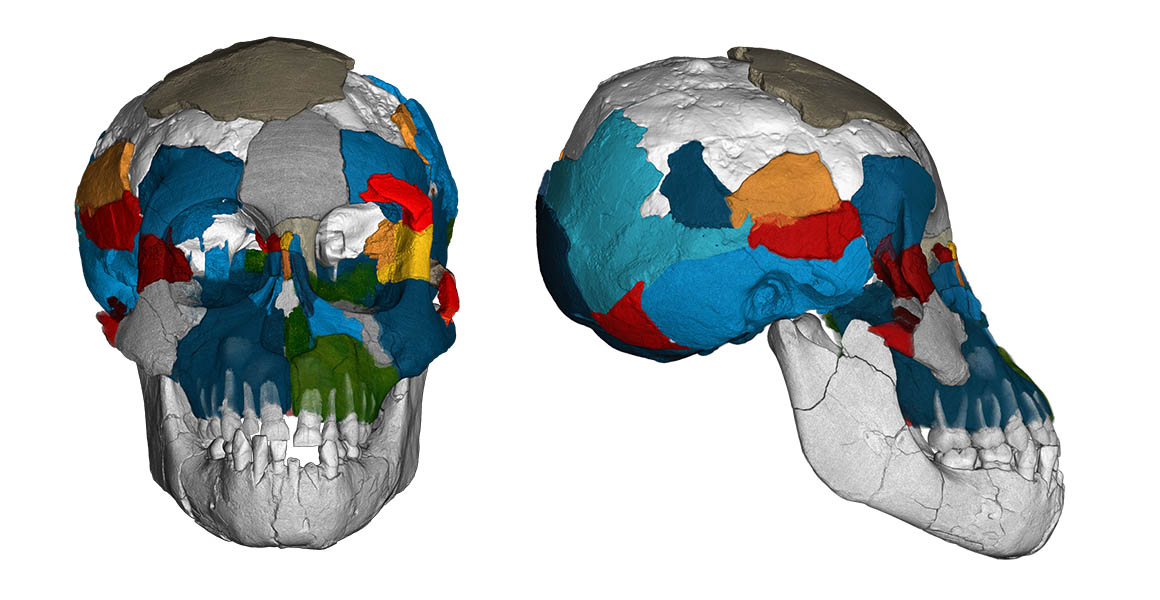
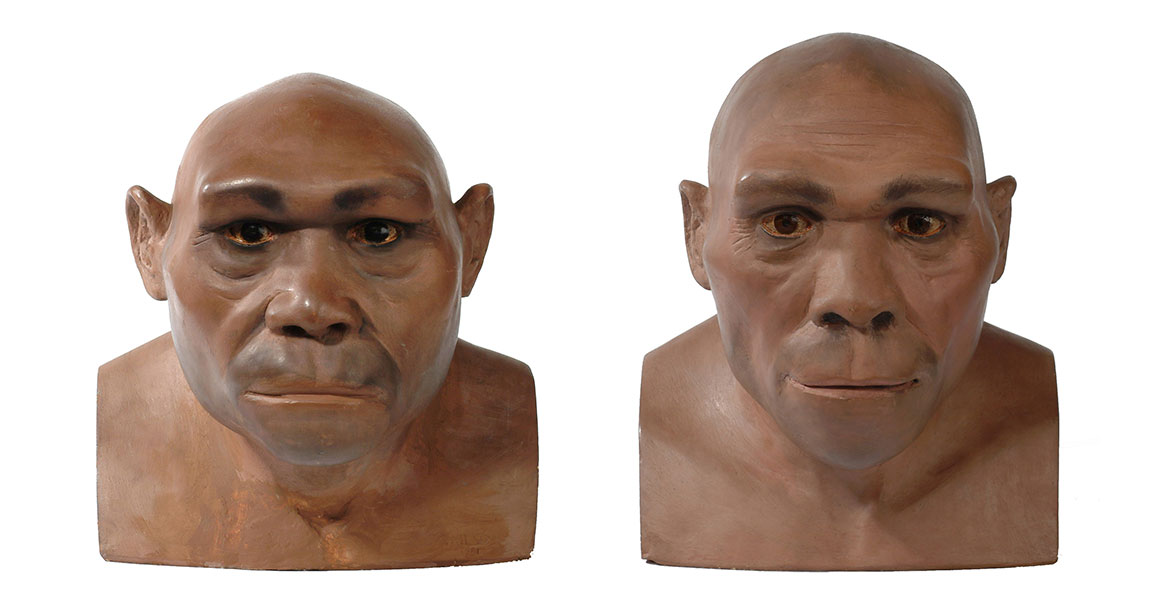
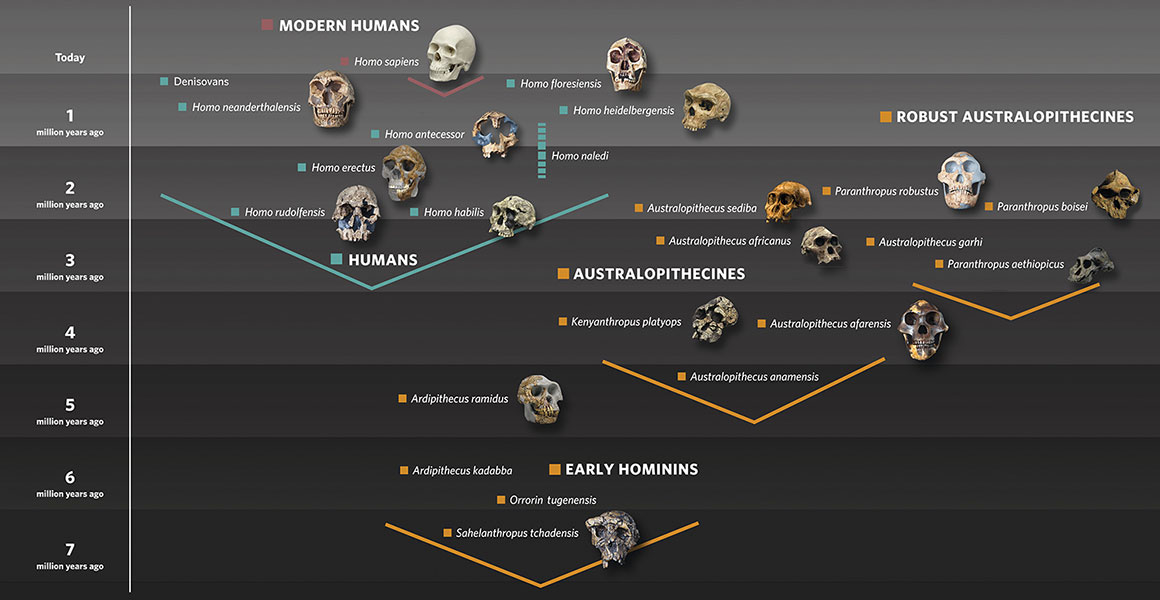
Don't miss a thing
Receive email updates about our news, science, exhibitions, events, products, services and fundraising activities. We may occasionally include third-party content from our corporate partners and other museums. We will not share your personal details with these third parties. You must be over the age of 13. Privacy notice.
Follow us on social media